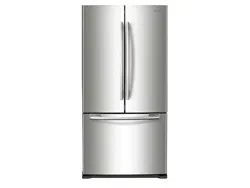Documents: Go to download!
- User Manual - (English)
- OPERATING YOUR SAMSUNG REFRIGERATOR
- TROUBLESHOOTING
Table of contents
User Manual Refrigerator
OPERATING YOUR SAMSUNG REFRIGERATOR
Parts and features
Use this page to become more familiar with the parts and features of the Refrigerator.

Using the control panel
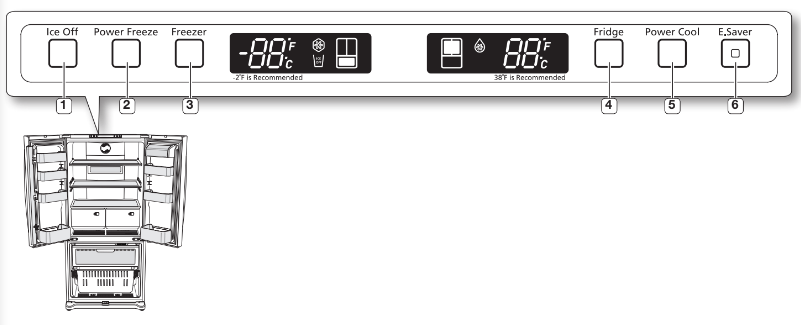
Temperature & Function select/control panel
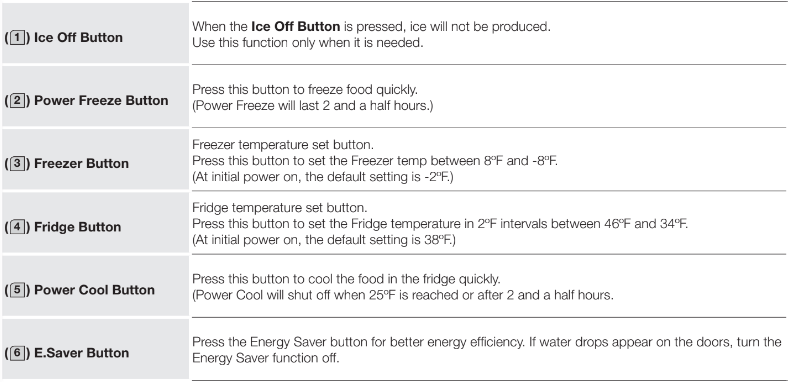
Controlling the temperature

Setting the freezer temperature
If you want to control the freezer temperature, follow as below.
Press the Freezer Button (Refer to the picture)
- The temperature can be set in 2oF interval between -8oF and 8oF.
See other models: RF22K9381SR RF23J9011SR WF340AN WF338AAW/XAA WF337
- Each time the Freezer Button is pressed, the temperature setting will change as follows;
(-2oF → -4oF → -6oF → -8oF → 8oF → 6oF → 4oF → 2oF → 0oF → -2oF)
When selecting the temperature, the set temperature is displayed initially for 5 seconds, then the actual temperature is displayed. (There may be a slight difference between the set temperature and the displayed actual temperature, but it will be corrected to the set temperature automatically.)

- The Freezer temperature will change depending on the number of door openings, the quantity of food, ambient temperature, etc.
- The temperature display will blink when the freezer temperature increases due to frequent door
opening, keeping warm food, etc.
(Blinking will stop when the refrigerator reaches normal temperature. If for some reason it does not stop after a long period of time, contact a Samsung service center.)
Setting the fridge temperature
If you want to control the fridge temperature, follow as below.
Press the Fridge Button (Refer to the picture)
- The temperature can be set in 2oF intervals between 34oF and 46oF.
- Each time the Fridge Button is pressed, the temperature setting will change as follows;
(38oF → 36oF → 34oF → 46oF → 44oF → 42oF → 40oF → 38oF)
When selecting the fridge temperature, the set temperature is displayed initially for 5 seconds, then the actual temperature is displayed. (There may be a slight difference between the set temperature and the displayed actual temperature, but it will be corrected to the set temperature automatically.)
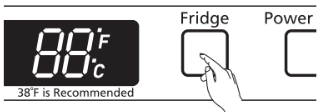
- The Fridge temperature will change depending on the number of door openings, the quantity of food, ambient temperature, etc.
- The temperature of each shelve or container in the fridge may be different.
- The temperature display will blink when the fridge temperature increases due to frequent door
opening, keeping warm food, etc.
(Blinking will stop when the refrigerator reaches normal temperature. If for some reason it does not stop after a long period of time, contact a Samsung service center.)
If you want to make ice faster (Controlling the Power Freeze)
Press the Power Freeze Button. (Refer to the picture.)
- The power Freeze light on the display goes on (see the arrow mark) and this function begins to
operate regardless of the set freezer temperature.
Press the Power Freeze Button again to cancel this function.
- The light goes off and it operates at the set freezer temperature again.

- The Power Freeze function operates for 2 and a half hours regardless of the set temperature.
If you want to speed up the cooling in the Fridge (Power Cool)
Press the Power Cool Button. (Refer to the picture.)
- The Power cool light on the display goes on (see the arrow mark) and this function begins to operate regardless of the set fridge temperature.
Press the Power Cool Button again to cancel this function.
- The light goes off and it operates at the set fridge temperature again.

- The Power Cool function operates for 2 and a half hours regardless of the set temperature.
Cooling Off Mode (“OF & OF” code on the display)
This function is for store display refrigerators. It is not for customer use.
CAUTION:
In Cooling Off Mode, the refrigerator works but doesn’t make cool air. To cancel this mode, press the Power Freeze and Freezer buttons at the same time for 3 seconds until a “Ding-dong” sound
is heard. The unit will now cool.

Ice Maker Operation
The ice maker will produce 8 cubes per cycle - approximately 100~130 cubes in a 24-hour period, depending on freezer compartment temperature, room temperature, number of door openings, and other use conditions.
Throw away the first few batches of ice to allow the water line to
clear.
Be sure nothing interferes with the sweep of the feeler arm. When the bin fills to the level of the feeler arm, the icemaker will stop producing ice.
After the icemaker has been turned on again, there will be a time delay before the icemaker resumes operation.
It is usual for several cubes to be joined together.
If ice is not used frequently, old ice cubes will become cloudy, taste stale, and shrink.
So if you don’t want to make ice, press the Ice Off button.

- When the “Ice making” function is selected,ice-making is a priority, Then the temperature of the freezer will be lower than the set temperature. If you don’t need the “Ice making” function, please press the button “Ice Off”.
Storing food in the refrigerator
The Samsung Refrigerator has been designed to provide maximum space-saving features and functions. Here are some of the customized compartments we have created to keep your food fresher for longer. In order to further prevent odor from seeping into the ice compartment, stored food should be wrapped securely and as airtight as possible.
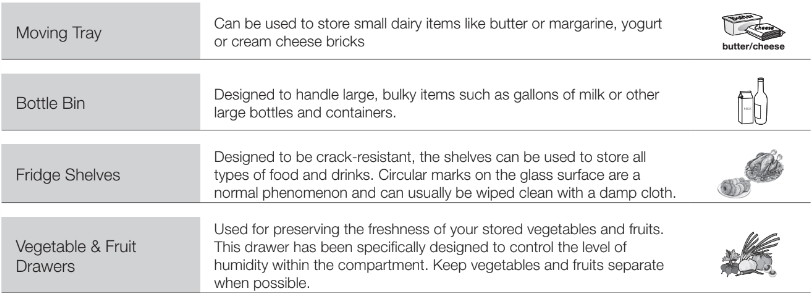
Do not place any large articles of food under the lamp in the Refrigerator. An air sensor is located
near the lamp and if the sensor is blocked, your Refrigerator may become too cold. Please place
Vegetables and Fruits in the Vegetable and Fruits Drawers to avoid freezing them. If the food in
your Refrigerator becomes frozen, please set the temperature higher.
Storing food in the freezer drawer

Bottles should be stored tightly together so that they do not tip and fall out when the Refrigerator
the door is opened.
If you plan to go away for a long time, empty the Refrigerator and turn it off. Wipe the excess
moisture from the inside of the appliance and leave the doors open. This helps keep odor and
mold from developing.
Removing the fridge accessories
-
Door Bins
To remove it - Simply lift the bin up and pull it straight out.
To replace it - Slide it in above the desired location and push it down until it stops.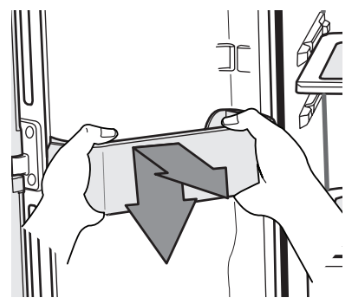 CAUTION: Injury may occur if the door bins are not firmly inserted. Do not allow children to play with bins. Sharp corners of the bins may cause injury. Do not adjust a bin full of food. Dust removal method -Remove the guard and wash in water.
CAUTION: Injury may occur if the door bins are not firmly inserted. Do not allow children to play with bins. Sharp corners of the bins may cause injury. Do not adjust a bin full of food. Dust removal method -Remove the guard and wash in water. -
Fridge shelves
To remove - When pulling out the shelf, if it does not slide out easily, lift it up slightly and pull it out again.
To replace - When pushing in the shelf, if it does not slide in easily, lift it up slightly and push in again.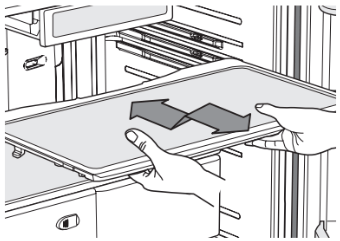 CAUTION: The Glass shelves are heavy. Use special care when removing them.
CAUTION: The Glass shelves are heavy. Use special care when removing them. -
Vegetable & Fruit Drawers
To remove - Pull the drawer out to full extension. Tilt up the front of the drawer and pull straight out. (Refer to picture 1~3)
To replace - Insert the drawer into the frame rails and push it back into place. (Refer to picture 4)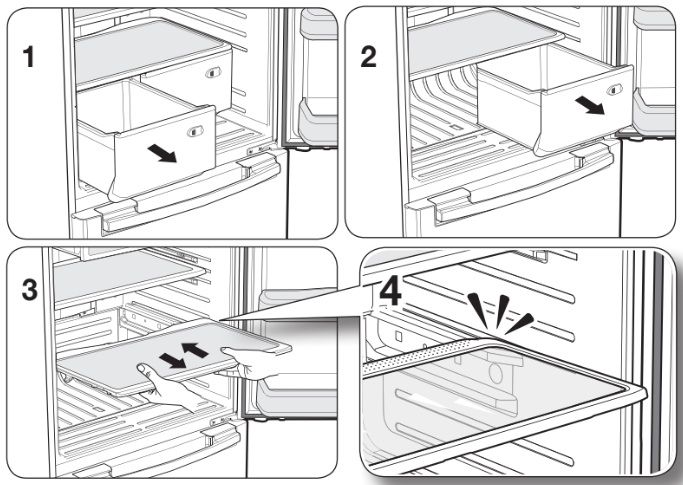
Removing the freezer accessories
- Pull Out Drawer
To remove - Pull the drawer out to full extension. Tilt up the rear of the drawer and lift straight out. (Refer to pictures 1 & 2)Open the freezer door fully and remove the drawer
To replace it - Place the drawer onto the rails by tilting it up. Lower the drawer into place until it is horizontal and slide the drawer in. (Refer to picture 3)

-
Freezer Drawer Bin
To remove the drawer - Pull the drawer out fully. Tilt up the rear of the bin and lift it out to remove it.
To relocate the drawer - Place the bin into the rail assembly. CAUTION: Do not allow babies or children to go inside the drawer bin. They could damage the Refrigerator and seriously injure themselves. Do not sit on the Freezer door. The door may break. Do not allow children to climb into the Freezer basket.
CAUTION: Do not allow babies or children to go inside the drawer bin. They could damage the Refrigerator and seriously injure themselves. Do not sit on the Freezer door. The door may break. Do not allow children to climb into the Freezer basket.
WARNING: If you remove the divider to clean the basket bin, you must reinstall the divider using 1 screw after cleaning to prevent children from getting trapped inside the basket.
Cleaning the refrigerator
Caring for your Samsung Refrigerator prolongs the life of your appliance and helps keep it odor and germ-free.
Cleaning the Interior
Clean the inside walls and accessories with a mild detergent and then wipe dry with a soft cloth. You can remove the drawers and shelves for a more thorough cleaning. Just make sure to dry
drawers and shelves before putting them back into place.
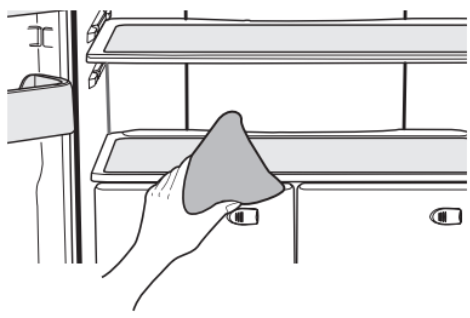
Cleaning the Exterior
Wipe the display panel with a damp, clean and soft cloth. Do not spray water directly on the surface of the Refrigerator. The door handles and cabinet surfaces should be cleaned with
mild detergent and then wiped dry with a soft cloth. To keep your appliance looking its best, the exterior should be polished once or twice a year.
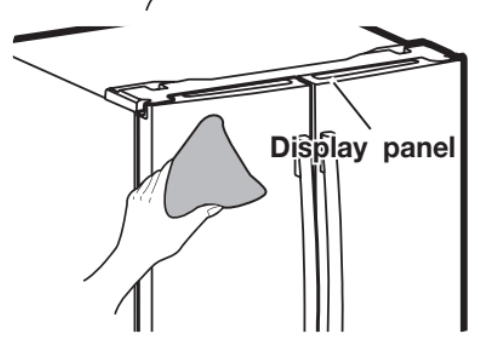
CAUTION: Do not use Benzene, Thinner, car detergent, or Clorox for cleaning. They may damage the surface of the appliance and may cause a fire. Printed letters on the display may come off if you spray the cleaning products directly on the product.
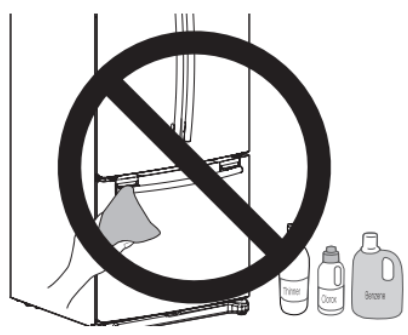
Cleaning the Rubber door seals
If the rubber door seals are dirty, the doors may not close properly, and the Refrigerator will not operate efficiently. Keep the door seals free of grit or grime by cleaning the doors with mild detergent and a damp cloth. Wipe dry with a clean, soft cloth.
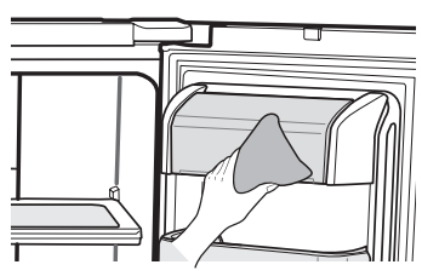
Cleaning behind the Refrigerator
To keep cords and exposed parts free of dust and dirt accumulation, vacuum behind the appliance once or twice a year.
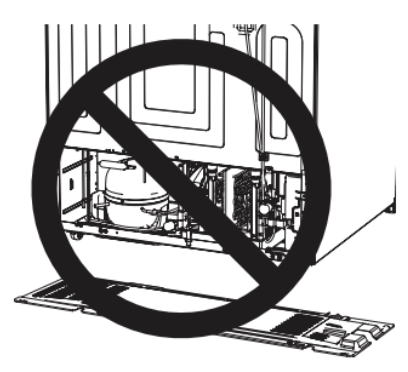
CAUTION: Do not remove the back cover. Doing so may cause an electric shock.
Changing the interior light
CAUTION:
Do not disassemble or replace the LED-type of Lighting.
To change the LED Type Lighting contact the Samsung service center or your authorized Samsung dealer.
If Users randomly exchange the LED lamp themselves, this may result in electric shock or personal injury.
When the interior or exterior LED lamp has gone out, please contact your service agents.
SAMSUNG CUSTOMER CARE CENTER
Samsung Electronics America, Inc. 85 Challenger Road Ridgefield Park, NJ 07660 1-800-SAMSUNG (1-800-726-7864)
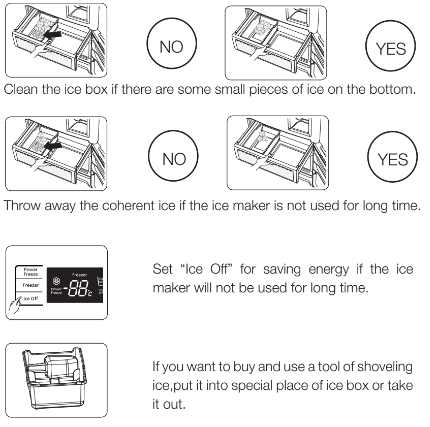
TROUBLESHOOTING
The Refrigerator does not work at all or it does not chill sufficiently.
- Check that the power plug is properly connected.
- Is the temperature control on the display panel set to the correct temperature? Try setting it to a lower temperature.
- Is the Refrigerator in direct sunlight or located near a heat source?
- Is the back of the Refrigerator so close to the wall that air cannot keep circulating (Refer to page 10 for the best location.)
The food in the Refrigerator is frozen.
- Is the temperature control on display set to the correct temperature? Try setting it to a warmer temperature.
- Is the temperature in the room too low?
- Did you store the food too close to the air vent at the back of the Refrigerator? Move the food away from the air vent.
You hear unusual noises or sounds.
- Check that the Refrigerator is level and stable.
- Is the back of the Refrigerator too close to the wall and therefore keeping air from circulating?
- Was anything dropped behind or under the Refrigerator?
- A “ticking” sound is heard from inside the Refrigerator. It is normal and occurs because various accessories are contracting or expanding according to the temperature of the Refrigerator interior.
- When the automatic ice maker is on, ice is made in the ice container. After the ice is made, the container inverts and the ice falls into the storage compartment and water flows through the water valve. These operations cause noise at regular intervals, but that noise is normal.
The front corners and vertical hinged section of the appliance are hot and condensation is occurring.
- Some heat is normal as anti-condensation is installed in the vertical hinged section of the Refrigerator to prevent condensation.
- Is the Refrigerator door ajar? Condensation can occur when you leave the door open for a long time.
Ice Maker is not producing ice.
- Did you wait for 12 hours after the installation of the water supply line before making ice?
- Is the water line connected and the shut-off valve opened?
- Did you manually stop the ice-making function?
- Is the Freezer temperature too warm? Try setting the Freezer temperature lower.
You hear water bubbling in the Refrigerator.
- This is normal. The bubbling comes from the Refrigerator coolant liquid circulating through the Refrigerator.
There is a bad smell in the refrigerator.
- Check for spoiled food.
- Foods with strong odors(for example, fish) should be tightly covered.
- Clean out your Freezer periodically and throw away any spoiled or suspicious food.
Frost forms on the walls of the Freezer.
- Is the air vent blocked? Remove any obstructions so air can circulate freely.
- Allow sufficient space between the foods stored for efficient air circulation.
- Is the Freezer drawer closed properly?
The water dispenser is not functioning. (Water dispenser models only)
- Is the water line connected and the shut-off valve opened?
- Has the water supply line tubing been crushed or kinked? Make sure the tubing is free and clear of any obstruction.
- Is the water tank frozen because the Refrigerator temperature is too low? Try selecting a warmer setting on the main display panel.
